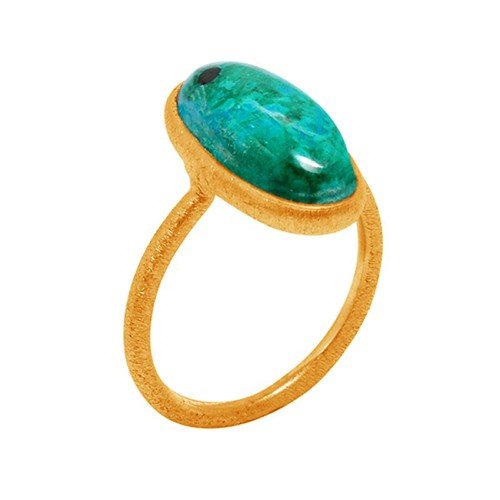Chrysocoll Stone Ring
Chrysocoll Stone Ring
2100
5100
Chrysocolla is a brightly colored bluish green crystal with a high copper content capturing the soft serenity of an ocean. It is a stone of the Goddess and empowers female energies. It draws negativity from your body, promotes peace and gentleness, soothes emotions, and encourages healthy communication. Chrysocolla is a teaching stone that stirs curiosity in its wearer and invites them to seek higher knowledge.
- 2.25 ratti
- 3.25 ratti
- 4.25 ratti
- 5.25 ratti
- 6.25 ratti
- 7.25 ratti
- 8.25 ratti
- 9.25 ratti
- 10.25 ratti
- 11.25 ratti
- 12.25 ratti
Chrysocolla History
Chrysocolla, the king of carbonate copper gemstones, is an alluring, vivid blue-green color and is often mistaken for turquoise because they share many visual similarities. It can often be found intermingled with malachite, turquoise and azurite, creating a wonderful mixed gemstone known as Eilat stone (named after the city where it was once mined). Legend has it that Eilat stone was originally quarried in King Solomon's mines in Africa--which is partly why it is the national stone of Israel. The rich, vibrant blue and green colors of chrysocolla are reminiscent of looking down upon the earth's surface from space.
The name chrysocolla was first used to describe the stone by Theophrastus, a Greek philosopher and botanist, in 315 B.C. The word was derived from the Greek words chrysos, meaning gold, and kola, meaning glue, referencing the fact that chrysocolla was employed from the earliest times by goldsmiths as an ingredient for solder, called santerna by the Romans, to weld gold pieces together. This fancy gemstone has indeed inspired creativity in many artists, whether they were ancient goldsmiths using it as solder, Renaissance painters grinding it as pigment for paint or modern jewelry designer-artists including it within their designs.
This stone lends itself well to opulence. Nero was a Roman Emperor and well-known patron of the green faction of ancient Rome. These ancient factions were split into four colors: red, white, blue and green and were elite clubs that people felt loyalty to above all others. They would have many competitions, such as chariot races, and would do anything to ensure that their club would win and be proven superior. The green faction was the most dominant club, so when Nero was to take part in a race as a charioteer, he dusted the circus arena with ground green chrysocolla powder instead of using the customary sand.
Chrysocolla can be found wherever large copper deposits occur, such as Africa, Mexico and the U.S. state of Arizona (where it is called Apache chrysocolla). Chrysocolla from the state of Arizona is a mixture of chrysocolla, turquoise, jasper, lapis, malachite and quartz crystal minerals.
Chrysocolla Metaphysical Properties
It is a long established fact that a reader will be distracted by the readable content of a page when looking at its layout. The point of using Lorem Ipsum is that it has a more-or-less normal distribution of letters, as opposed to using 'Content here, content here', making it look like readable English. Many desktop publishing packages and web page editors now use Lorem Ipsum as their default model text, and a search for 'lorem ipsum' will uncover many web sites still in their infancy. Various versions have evolved over the years, sometimes by accident, sometimes on purpose.
There are many variations of passages of Lorem Ipsum available, but the majority have suffered alteration in some form, by injected humour, or randomised words which don't look even slightly believable.
Review
There are no review yet
Add A Review
Your email address will not be published.






